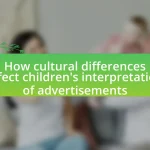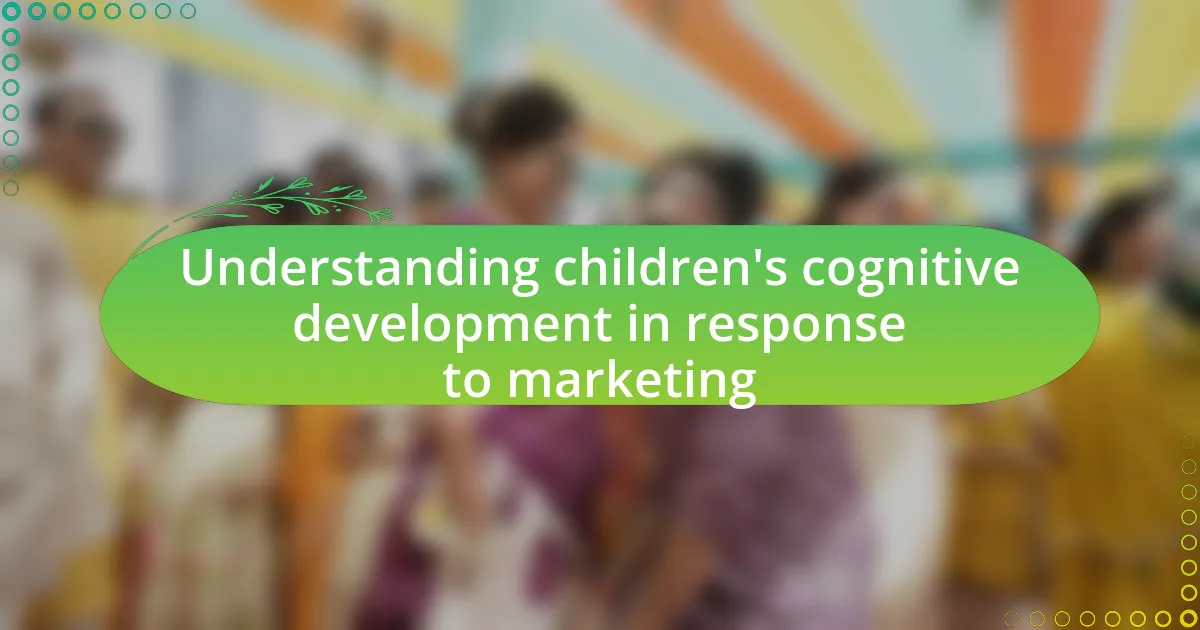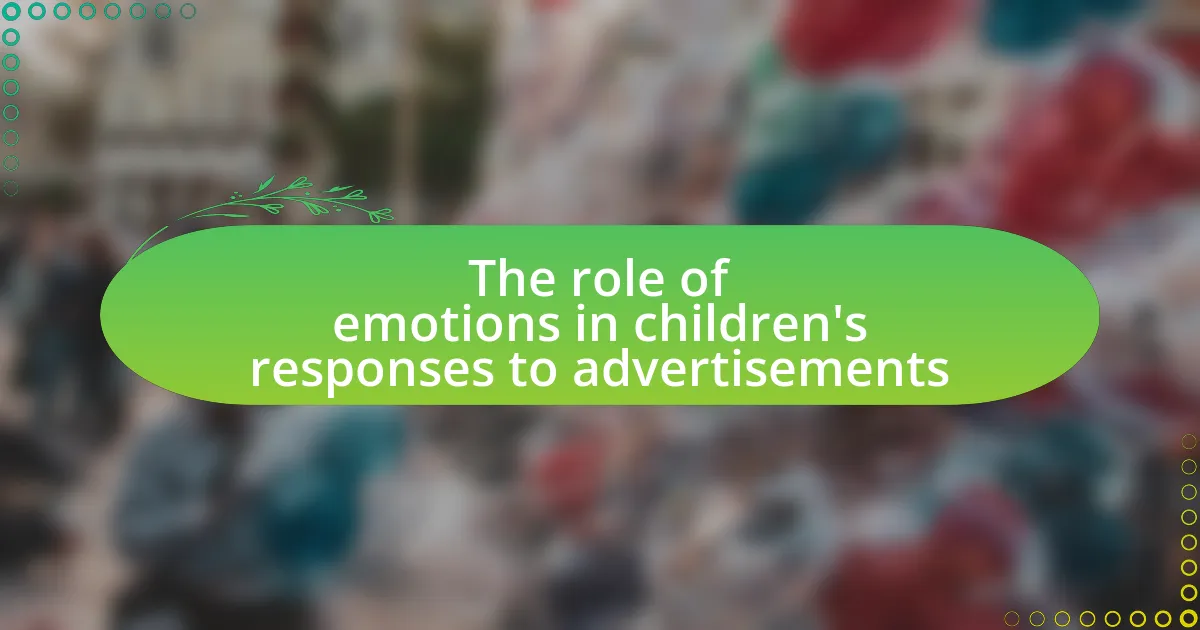The article examines how children’s understanding of advertising evolves with age, highlighting key developmental stages from preschool through adolescence. It details how young children perceive ads primarily as entertainment, while older children begin to recognize persuasive intent and advertising techniques. The influence of cognitive development, media literacy, and social interactions on children’s interpretation of advertising is discussed, along with the role of parental attitudes and peer influence. Additionally, the article emphasizes the importance of media literacy education in helping children critically evaluate advertisements and make informed consumer choices.
How does children’s understanding of advertising change as they grow?
Children’s understanding of advertising evolves significantly as they grow, transitioning from a simplistic acceptance of messages to a more critical analysis of content. Young children, typically under the age of 7, often perceive advertisements as entertainment and have difficulty distinguishing between ads and regular programming. As they reach ages 8 to 12, children begin to recognize persuasive intent and can identify the purpose of advertisements, understanding that they are designed to sell products. By adolescence, around ages 13 and older, teenagers develop a more sophisticated understanding, critically evaluating advertising techniques and recognizing manipulative strategies, such as emotional appeals and celebrity endorsements. Research indicates that this progression is influenced by cognitive development, media literacy education, and social experiences, which collectively enhance their ability to analyze and interpret advertising messages effectively.
What are the key developmental stages in children’s understanding of advertising?
Children’s understanding of advertising evolves through several key developmental stages: at ages 2 to 5, children typically recognize advertisements but do not understand their persuasive intent; between ages 5 to 7, they begin to comprehend that ads are designed to sell products; from ages 8 to 10, children start to critically evaluate advertisements and recognize techniques used to attract attention; and by ages 11 and up, they develop a more sophisticated understanding of advertising strategies, including manipulation and emotional appeal. Research by John P. Murray and colleagues highlights these stages, indicating that children’s cognitive development significantly influences their ability to interpret advertising messages.
How do preschoolers perceive advertisements?
Preschoolers perceive advertisements primarily as entertaining and engaging content rather than as persuasive messages. Research indicates that children aged 3 to 5 often focus on the visual and auditory elements of ads, such as bright colors, catchy jingles, and animated characters, which capture their attention. A study by the American Psychological Association found that preschoolers have difficulty distinguishing between program content and advertisements, leading them to view ads as part of the entertainment rather than as marketing aimed at influencing their purchasing decisions. This lack of critical understanding means that preschoolers are more likely to accept the messages in advertisements at face value, often believing that the products will deliver the fun and excitement portrayed in the ads.
What cognitive abilities do children develop by age 5 regarding advertising?
By age 5, children develop the cognitive ability to recognize advertising as a form of communication intended to persuade them to purchase products. At this age, they begin to understand that advertisements are designed to promote specific items and can differentiate between commercial content and regular programming. Research indicates that children start to grasp the persuasive intent behind ads, as evidenced by studies showing that they can identify brand logos and associate them with specific products. This recognition is foundational for later critical thinking about advertising messages and their intent.
Why is it important to study children’s understanding of advertising?
Studying children’s understanding of advertising is crucial because it reveals how they interpret and respond to marketing messages, which can significantly influence their consumer behavior. Research indicates that children develop cognitive skills and critical thinking abilities at different ages, impacting their ability to discern persuasive intent in advertisements. For instance, a study by John and Roberts (2005) found that children under the age of 8 are generally unable to recognize the persuasive nature of advertising, while older children begin to understand that advertisements are designed to sell products. This understanding is essential for developing effective educational strategies that promote media literacy and protect children from manipulative marketing practices.
How does advertising impact children’s behavior and choices?
Advertising significantly influences children’s behavior and choices by shaping their preferences and consumption patterns. Research indicates that children are particularly susceptible to advertising due to their developing cognitive abilities, which makes them less critical of marketing messages. For instance, a study published in the journal “Pediatrics” found that children exposed to food advertisements are more likely to choose unhealthy snacks over healthier options, demonstrating a direct link between advertising exposure and dietary choices. Additionally, children aged 8 to 12 are more likely to imitate behaviors seen in advertisements, which can lead to increased materialism and a desire for products they may not need. This impact is compounded by the fact that children often lack the skills to discern persuasive intent in advertising, making them more vulnerable to its effects.
What role does media literacy play in children’s understanding of advertising?
Media literacy significantly enhances children’s understanding of advertising by equipping them with critical thinking skills necessary to analyze and evaluate media messages. Research indicates that children with higher media literacy are better able to discern persuasive intent and recognize advertising techniques, such as emotional appeals and misleading claims. For instance, a study published in the Journal of Advertising Research found that children who received media literacy education demonstrated improved ability to identify advertisements and differentiate them from other content, leading to more informed consumer choices. This understanding helps children navigate the complex media landscape as they grow older, fostering a more skeptical and analytical approach to advertising.
What factors influence the evolution of children’s understanding of advertising?
Children’s understanding of advertising evolves due to cognitive development, social influences, and exposure to media. Cognitive development, as outlined by Piaget’s stages, indicates that as children grow, they transition from concrete operational thinking to more abstract reasoning, allowing them to critically analyze advertisements. Social influences, including parental guidance and peer interactions, shape children’s perceptions and interpretations of advertising messages. Additionally, increased exposure to various media forms, such as television and the internet, enhances their familiarity with advertising techniques, further refining their understanding. Research by John and Roberts (2009) in “The Influence of Parental Communication on Children’s Understanding of Advertising” supports these factors, demonstrating that children’s comprehension of advertising is significantly impacted by their developmental stage and environmental context.
How do parental attitudes towards advertising affect children’s perceptions?
Parental attitudes towards advertising significantly shape children’s perceptions by influencing how they interpret and respond to marketing messages. When parents express skepticism or critical views about advertising, children are more likely to adopt a similar critical stance, leading to enhanced media literacy and a questioning attitude towards advertisements. Conversely, if parents display a positive attitude towards advertising, children may develop a more accepting view, potentially leading to increased susceptibility to marketing tactics. Research indicates that children as young as 3 years old begin to internalize their parents’ attitudes, which can persist into later childhood and adolescence, affecting their consumer behavior and understanding of advertising’s persuasive intent.
What strategies can parents use to discuss advertising with their children?
Parents can use several strategies to discuss advertising with their children, including encouraging critical thinking, using real-life examples, and fostering open dialogue. Encouraging critical thinking involves asking children questions about advertisements, such as what message the ad is trying to convey and whether it is truthful. This approach helps children analyze and evaluate the content they encounter. Using real-life examples, such as discussing commercials during family viewing time, allows parents to contextualize advertising messages and demonstrate how they can influence perceptions and behaviors. Fostering open dialogue creates a safe space for children to express their thoughts and feelings about advertisements, enabling parents to address misconceptions and reinforce media literacy. Research indicates that children’s understanding of advertising evolves significantly as they age, with younger children often unable to distinguish between entertainment and advertising, while older children develop a more critical perspective.
How does exposure to different types of media shape children’s understanding?
Exposure to different types of media significantly shapes children’s understanding by influencing their cognitive development, social skills, and perception of reality. Research indicates that children who engage with diverse media formats, such as television, video games, and the internet, develop critical thinking skills and media literacy, which are essential for interpreting advertisements. For instance, a study by Valkenburg and Peter (2011) found that children exposed to educational media content demonstrated improved comprehension and analytical skills compared to those with limited media exposure. This exposure also affects their ability to discern persuasive intent in advertising, as children learn to recognize marketing strategies and differentiate between entertainment and information.
What role does peer influence play in children’s understanding of advertising?
Peer influence significantly shapes children’s understanding of advertising by affecting their perceptions and interpretations of marketing messages. As children interact with peers, they often discuss and share opinions about advertisements, which can lead to a collective understanding that may differ from parental views. Research indicates that children aged 8 to 12 are particularly susceptible to peer influence, as they begin to value social acceptance and group norms, which can lead them to adopt attitudes toward brands and products that are popular among their friends. This social dynamic is supported by studies showing that children are more likely to remember and engage with advertisements that their peers endorse, highlighting the importance of social context in their comprehension of advertising.
How do children’s social interactions impact their interpretation of advertisements?
Children’s social interactions significantly influence their interpretation of advertisements by shaping their understanding of social norms and peer influences. As children engage with peers, they develop critical thinking skills and social awareness, which affect how they perceive marketing messages. For instance, research indicates that children aged 8 to 12 are more likely to interpret advertisements through the lens of social acceptance, often seeking validation from friends regarding product choices. This peer influence can lead to a heightened susceptibility to persuasive advertising techniques, as children may prioritize products endorsed by their social circles. Studies, such as those conducted by the American Psychological Association, show that children who frequently discuss advertisements with peers are better at recognizing persuasive intent, thus altering their interpretation of marketing content.
What are the effects of group dynamics on children’s responses to advertising?
Group dynamics significantly influence children’s responses to advertising by shaping their perceptions and behaviors through social interactions. When children are in groups, they often conform to the opinions and preferences of their peers, which can enhance the effectiveness of advertisements that appeal to group identity or social acceptance. Research indicates that children aged 8 to 12 are particularly susceptible to peer influence, as they seek validation from their peers, making them more likely to respond positively to advertisements that are endorsed by friends or popular figures. For instance, a study published in the Journal of Advertising Research found that children exposed to advertisements in a group setting were more likely to express interest in the advertised products compared to when they viewed the same ads alone. This demonstrates that group dynamics can amplify children’s engagement with advertising, leading to increased brand recognition and purchase intent.
How can we support children’s understanding of advertising as they grow?
To support children’s understanding of advertising as they grow, parents and educators can engage them in discussions about the purpose and techniques of advertising. Research indicates that children as young as 5 years old can begin to differentiate between content and advertising, but their critical thinking skills develop significantly around ages 8 to 12. During this period, adults can facilitate learning by analyzing advertisements together, discussing persuasive techniques, and encouraging children to question the messages being conveyed. For instance, studies show that children who participate in media literacy programs demonstrate improved critical thinking regarding advertising. By fostering an environment where children can express their thoughts and ask questions about advertisements, adults can enhance their ability to understand and critically evaluate advertising messages as they mature.
What educational approaches can enhance children’s media literacy?
Educational approaches that can enhance children’s media literacy include critical media analysis, interactive learning experiences, and the integration of media literacy into the curriculum. Critical media analysis teaches children to evaluate and question media messages, fostering a deeper understanding of advertising techniques and persuasive strategies. Interactive learning experiences, such as role-playing and hands-on projects, engage children in active learning, allowing them to apply media literacy concepts in real-world contexts. Furthermore, integrating media literacy into the curriculum across subjects ensures that children develop these skills consistently, as supported by research from the National Association for Media Literacy Education, which emphasizes the importance of comprehensive media literacy education in developing critical thinking skills.
How can schools incorporate advertising education into their curriculum?
Schools can incorporate advertising education into their curriculum by integrating it into subjects like media literacy, marketing, and social studies. This approach allows students to analyze advertisements critically, understand persuasive techniques, and recognize the impact of advertising on consumer behavior. Research indicates that children’s understanding of advertising evolves significantly as they age, with younger children often unable to distinguish between content and advertisements, while older students develop a more nuanced understanding. By including advertising education, schools can equip students with essential skills to navigate a media-saturated environment effectively.
What resources are available for parents to teach children about advertising?
Parents can utilize various resources to teach children about advertising, including educational websites, books, and interactive activities. Websites like Common Sense Media provide guides and articles that explain advertising concepts in child-friendly language. Books such as “The Advertising Effect: How to Change Behavior” by Adam Ferrier offer insights into advertising strategies that can be simplified for younger audiences. Additionally, interactive activities, such as creating mock advertisements or analyzing commercials together, can enhance understanding. Research indicates that children’s comprehension of advertising evolves significantly by age 8, making these resources particularly valuable for parents aiming to foster critical thinking skills regarding media consumption.
What practical tips can help children critically evaluate advertisements?
To help children critically evaluate advertisements, encourage them to ask questions about the ad’s message, target audience, and persuasive techniques used. Teaching children to identify the purpose of an advertisement—whether to inform, persuade, or entertain—can enhance their understanding. For instance, children should be guided to consider who created the ad and why, which fosters critical thinking. Additionally, discussing the difference between needs and wants can help them recognize manipulative tactics. Research indicates that children as young as eight can begin to understand advertising strategies, making it essential to engage them in discussions about the intent behind ads.
How can children learn to identify persuasive techniques in advertising?
Children can learn to identify persuasive techniques in advertising through education and critical thinking exercises. Engaging children in discussions about advertisements helps them recognize common persuasive strategies, such as emotional appeals, celebrity endorsements, and the use of vivid imagery. Research indicates that children as young as 8 years old can begin to understand these techniques when they are taught to analyze advertisements critically. For instance, a study by the American Psychological Association found that media literacy programs significantly improve children’s ability to discern persuasive intent in ads. By practicing these skills, children develop a more nuanced understanding of advertising as they grow older.
What activities can parents and children do together to discuss advertising?
Parents and children can engage in activities such as analyzing advertisements together, creating their own ads, and discussing the intent behind various marketing strategies. Analyzing advertisements allows children to identify persuasive techniques, such as emotional appeals or celebrity endorsements, which enhances their critical thinking skills regarding media. Creating their own ads fosters creativity and helps children understand the components of effective advertising. Discussing the intent behind marketing strategies, such as targeting specific demographics, provides insight into how advertising influences consumer behavior. These activities not only promote awareness but also encourage open dialogue about the impact of advertising on their perceptions and choices.






